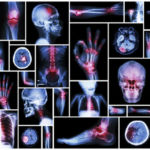Emily has learned to deal with the challenges of raising 2 children despite her Ehlers-Danlos Syndrome.
By EMMA INNES
“A mother has been left devastated by a rare condition that leaves her barely able to cuddle her children.
Emily Comber, 31, suffers from a rare syndrome that causes her constant pain and makes her joints ‘pop out’ up to five times a day.
It means she can barely pick up her one-year-old son Reuben and has even dislocated her shoulder changing a nappy.
Emily Comber (pictured with her husband, James) has Ehlers-Danlos syndrome which means the collagen in her body is weak so her joints dislocate easily and she is in constant pain
Mrs Comber suffers from Ehlers-Danlos syndrome – a genetic condition which means the collagen in her body is too weak to hold her limbs in place.
The mother-of-two from Bude, Cornwall, said: ‘My ribs have popped out when I’ve been picking Reuben up out of his cot and I’ve even dislocated my wrist and thumb when changing his nappy.
‘My ribs go multiple times a day – it can be something small that sets them off like just shutting a car door.
‘It leaves me in so much pain, it’s like popping the lid on a jar, but now I’ve learned to deal with it better. It was much worse when I was younger and they didn’t know what was happening.
‘On my worst days it hurts just to breathe.’
Mrs Comber suffers from type three Ehlers-Danlos syndrome, which means she suffers from joint hypermobility and has long arms and legs.
Mrs Comber’s joints ‘pop out’ up to five times a day and she has dislocated her shoulder, wrist and thumb changing her son’s nappy. She is pictured with her children, Ruben, one, and Finlay, three
She has suffered from the condition since she was a child, but it is notoriously difficult to diagnose.
It was only when she became pregnant with her first child, Finlay, now three, that she was diagnosed.
Mrs Comber said: ‘I was in agony. I couldn’t walk. I got referred to a specialist and they were sure I had it as soon as I entered the office.
‘The situation was so bad I was bedbound for three weeks and they only rolled me once every 24 hours, but otherwise couldn’t move me until after the C-section.
‘I gave birth eight weeks early. They just had to get the baby out of me.’
Mrs Comber was diagnosed when she was pregnant with her first child, Finlay. During the pregnancy she was in so much pain she considered not having any more children but eventually decided to have Ruben (pictured)
She added: ‘It’s a 50 per cent chance of passing it on to your children. We won’t know for sure until they get older, but Finlay is already showing symptoms.
‘It does worry me. I feel guilty. If either of them have got it then it’s come from me.’
Mrs Comber and her husband James, a builder, thought long and hard before having their second child after the strain it put on Mrs Comber’s body first time around.
She said: ‘It did put us off having another child, but we planned everything the second time. We had a lot of special help.
‘We had Reuben four weeks early as a planned thing. We both knew what was happening at every stage of the pregnancy.’
Mrs Comber said: ‘It leaves me in so much pain, it’s like popping the lid on a jar, but now I’ve learned to deal with it better. It was much worse when I was younger and they didn’t know what was happening’
But since Reuben has been born the condition has presented itself in different ways and even picking the baby up out of his bed can leave her in agony.
She now has a carer who helps her for 14 hours a week.
She has also taken up dressage for people with disabilities and managed to walk down the aisle without her crutches.
She said: ‘Originally I wanted to go away and get married somewhere where no-one could see us, but it was actually really nice.
‘I had to lean on my dad to get down the aisle and we sat for a lot of the service.
Mrs Comber was so ill when she was pregnant with Finlay that she was bedbound for three weeks and he had to be delivered eight weeks early. He is pictured shortly after his birth
‘James carried me for a lot of the day, but we were on the beach in the middle of a heat wave so it just looked normal.
‘It took me a week to recover. I’ve taken up para-dressage riding and it really helps. Along with my family it helps keep me sane. I think I would otherwise lose the plot with the high levels of pain.’
British actress Cherylee Housten, who plays Izzy Armstrong in Coronation Street, also suffers from EDS and is the ambassador for the charity Ehlers-Danlos Support UK.
Lara Bloom, manager of the charity, said: ‘The condition affects the connective tissue in the body. It can cause problems with joints and internal organs.
‘The vascular form of the disease can also shorten life expectancy.’
For more information on EDS visit www.ehlers-danlos.org
WHAT IS EHLERS-DANLOS SYNDROME?
Ehlers-Danlos syndrome is a group of inherited conditions that affect collagen proteins in the body causing them to be weak.
Typical features are stretchy skin, loose joints and fragile body tissues.
Collagen is a building block that strengthens and supports various body tissues – it is found in tendons, ligaments, cartilage, skin, bone, blood vessels and the spine.
EDS is caused by alterations in certain genes – these can be passed from parents to their children.
The condition affects at least one person in every 5,000 in the UK.
There are various different forms of EDS. All share some common features, such as loose joints, abnormal skin and fragile body tissues, but each form of EDS has unique characteristics too.
The most severe form is Vascular EDS which causes the organs and blood vessels to be at risk of rupturing – this can be fatal.
The life expectancy for people with Vascular EDS is in the 40s.”
Emily is promoting EDS Awareness in the UK. A very inspirational story!
Click here for the original source of this article
We appreciate your Likes and Comments


